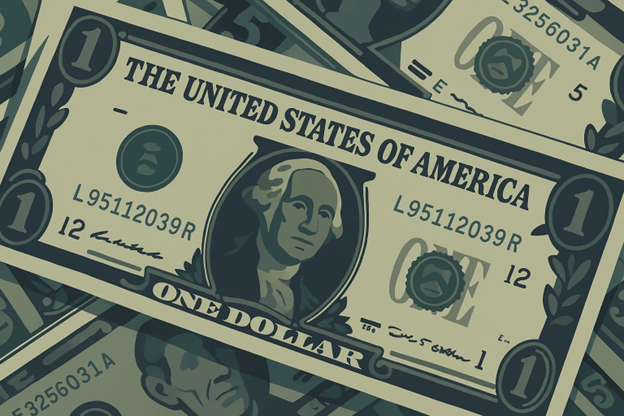DXY Breaks Below 100: Will U.S. Data and NFP Trigger a Dollar Rebound or Deeper Fall?
2025-04-28 13:46:52

DXY Breaks Below 100: Will U.S. Data and NFP Trigger a Dollar Rebound or Deeper Fall?
The U.S. dollar stayed under intense selling pressure through the final week of April, capping off its worst monthly performance so far this year.
- The U.S. dollar ended April with its worst monthly performance in years, slipping below the critical 100 level as bearish sentiment gained momentum.
- Modest rebounds driven by political tensions, solid U.S. data, and tariff downgrades provided temporary support but failed to shift the broader bearish outlook.
- This week’s major events, including NFP and key economic data, will likely determine whether the dollar stabilizes or resumes its slide toward new lows.
Sentiment surrounding the dollar has clearly shifted, and the outlook is turning increasingly negative as we head into May.

The greenback posted sharp losses against major currencies, with the Dollar Index (DXY) falling below the key 100 mark for the first time in more than three years — a significant psychological setback for dollar bulls.
However, the dollar managed to claw back a portion of its losses since April 21, finding brief pockets of support driven by several factors:
1. A recall of Trump’s comments of firing the Fed Chair, Jerome Powell.

In mid-April 2025, Trump intensified his criticism of Powell, labeling him "a major loser" and stating that Powell's "termination cannot come fast enough.”
Although Trump later clarified that he had "no intention" of firing Powell, the damage to market confidence had already been done.
2. Solid U.S. Data Provides a Temporary Lift to the Dollar

These solid economic reports painted a picture of a still-resilient U.S. economy:
- Stronger consumer demand → boosts GDP outlook.
- Tight labor market → keeps wage growth pressures alive.
- Manufacturing recovery → reduces recession fears.
All of this reduced the urgency for Fed rate cuts, providing the dollar temporary fundamental support even as broader risks loom ahead.
The combination of strong U.S. consumption, a firm labor market, improving manufacturing, and steady Fed messaging helped the dollar recover from deeply oversold levels ahead of the critical NFP report.
Check out the previous analysis: https://acy.com/en/market-news/market-analysis/gold-retreats-3500-dollar-rebounds-us-data-j-o-04252025-135047/
3. U.S.-China Tariff Potential Rate Downgrade Supported the Dollar (Short-Term)

Over the past week, there have been reports that the U.S. may reduce some of the previously proposed tariff hikes on Chinese goods — scaling them back from extreme levels like 145% down to around 50–65%
Why would this help the dollar?
- Eases Inflation Fears:
Lower tariffs mean less upward pressure on consumer prices. That reduces fears of stagflation (high inflation + low growth), which had been weighing heavily on U.S. economic sentiment.
- Supports Consumer Spending:
With lower tariffs, imported goods remain cheaper. American consumers can maintain their spending power, helping to support economic growth, which is bullish for the dollar.
- Reduces Trade War Uncertainty:
Even partial tariff relief eases global market anxiety. This helps risk sentiment recover, while also reducing pressure on the Fed to react aggressively with rate cuts — indirectly stabilizing the dollar.
- Improves Capital Flows:
If markets believe the trade war risks are peaking or easing, foreign investment into U.S. assets can recover, which supports dollar demand.
Even though the dollar remains under broader pressure from other factors (Fed cuts, twin deficits, global rotation), the news of tariff reductions against China has been a short-term positive catalyst, helping the dollar rebound from its recent oversold levels.
U.S. Dollar in Focus Ahead of Crucial NFP Test
But now, all eyes are locked on one major event that could change everything: this Friday’s Non-Farm Payrolls (NFP) report.

With concerns mounting over slowing U.S. growth, stubborn inflation, and rising trade tensions, this week’s jobs data could tip the balance. Economists are forecasting a cooling labor market, a 4.2% unemployment rate and lower than previous numbers of 130k dropping from 228k.
The stakes are high:
- A strong NFP could stabilize the dollar, suggesting the U.S. economy remains resilient despite trade headwinds and Fed caution.
- A weak NFP would confirm slowing momentum and reinforce bets that the Fed will start cutting rates as early as Q3.
Brace for Impact: Other Key Upcoming U.S. Economic Events
Aside from NFP, several high-impact U.S. data releases are scheduled this week. Their outcomes could heavily influence whether the U.S. dollar extends its rebound — or resumes its downtrend.

What This Could Imply for the Dollar:

If U.S. jobs, consumer spending, inflation, and manufacturing data beat expectations, the dollar could extend its recovery, especially against weaker currencies like the yen or Aussie.
But if GDP and ISM show sharp weakening, and inflation falls faster than expected, markets would likely price in more aggressive Fed rate cuts — causing the dollar to resume its broader downtrend.
Bottom Line:
This cluster of data (especially Core PCE and GDP) is critical because it sets the tone heading into NFP.
- Strong numbers = dollar support into NFP.
- Weak numbers = dollar vulnerability grows even before NFP hits.
Technical Outlook

Although the dollar experienced a modest and temporary recovery, it was not enough to signal a full reversal or unlock meaningful upside potential. Selling pressure remains more evident than buying interest, and the path of least resistance continues to favor further downside moves.
- If the dollar strengthens (fundamentals beat expectations and DXY reclaims and holds above 100), major currencies like the euro, pound, and Aussie are likely to face renewed selling pressure, while the yen may weaken moderately as risk aversion rises. Overall, we could see a broad retreat across major pairs against the dollar as the greenback regains momentum.
- If the dollar weakens (fundamentals disappoint and DXY fails to sustain above 100), major currencies are likely to extend their rallies. The euro and pound would likely break through key resistance zones, while risk-sensitive currencies like the Aussie could gain further ground. The yen could strengthen sharply if risk appetite also improves, leading to broad dollar selling across the board.
There are more scenarios that we can see out of this, our approach is to look for confirmations if price is willing to go to a certain direction.
Actionable Trading Approach

Step 1: Set Clear Scenarios
Before any trade, outline both bullish and bearish outcomes based on the data. Know what you expect and what invalidates your view.
Step 2: Wait for Confirmation
Do not react to the first spike after news. Let the market show its hand — through a sustained breakout, retest, or clear reversal pattern.
Step 3: Align Structure and Momentum
Only take trades when technical structure (support/resistance break) aligns with the underlying momentum and the fundamental backdrop.
Step 4: Manage Risk Proactively
Use smaller position sizes around volatile events. Scale up only if the trend extends cleanly after confirmation.
Step 5: Stay Adaptive
If the data surprises or price reacts unexpectedly, drop your bias and adjust. In fast-moving markets, flexibility is a trader’s real edge.
Final Thoughts

"Patience is not simply the ability to wait — it's how we behave while we're waiting."
— Dr. Brett Steenbarger, trading psychologist and performance coach
With the U.S. dollar sitting at a critical crossroads, the next few days of fundamental releases will likely set the tone for May. Whether the greenback can reclaim strength or continues its broader decline will depend on how markets react to incoming data — not just the numbers themselves, but the overall shifts in sentiment. As volatility picks up, the key is to stay patient, wait for confirmation, and let price action reveal the real story. In this environment, discipline and adaptability will be far more valuable than prediction.
Check Out Our Market Education
Learn how to navigate yourself in times of turmoil. Check out my market education links:
Want to learn how to trade like the Smart Money? Check out my new contents:
https://acy.com/en/market-news/education/smc-playbook-series-beginners-guide-j-o-04032025-155530/
Follow me on LinkedIn: https://www.linkedin.com/in/jasperosita/
This content may have been written by a third party. ACY makes no representation or warranty and assumes no liability as to the accuracy or completeness of the information provided, nor any loss arising from any investment based on a recommendation, forecast or other information supplies by any third-party. This content is information only, and does not constitute financial, investment or other advice on which you can rely.
Try These Next
4 Powerful Tactics to Overcome the Most Costly Forex Mistakes
How to Master MT4 & MT5 - Tips and Tricks for Traders
The Importance of Fundamental Analysis in Forex Trading
Forex Leverage Explained: Mastering Forex Leverage in Trading & Controlling Margin
The Importance of Liquidity in Forex: A Beginner's Guide
Close All Metatrader Script: Maximise Your Trading Efficiency and Reduce Stress
Best Currency Pairs To Trade in 2025
Forex Trading Hours: Finding the Best Times to Trade FX
MetaTrader Expert Advisor - The Benefits of Algorithmic Trading and Forex EAs
Top 5 Candlestick Trading Formations Every Trader Must Know















